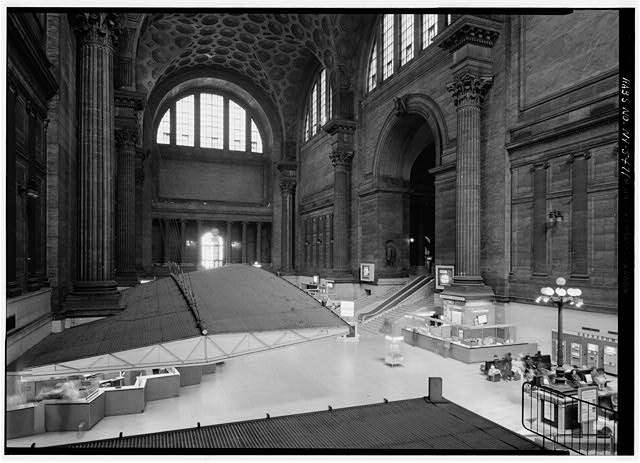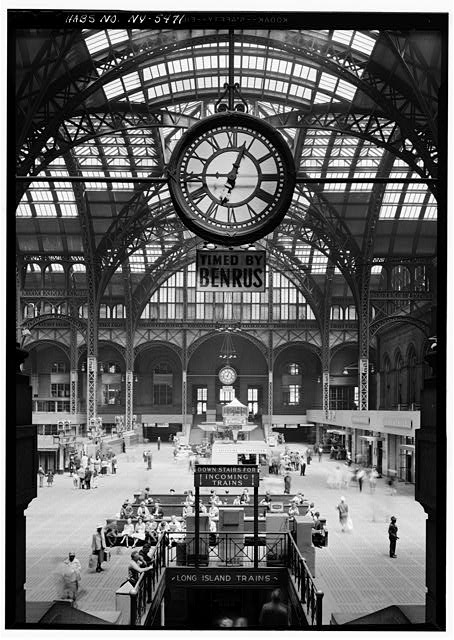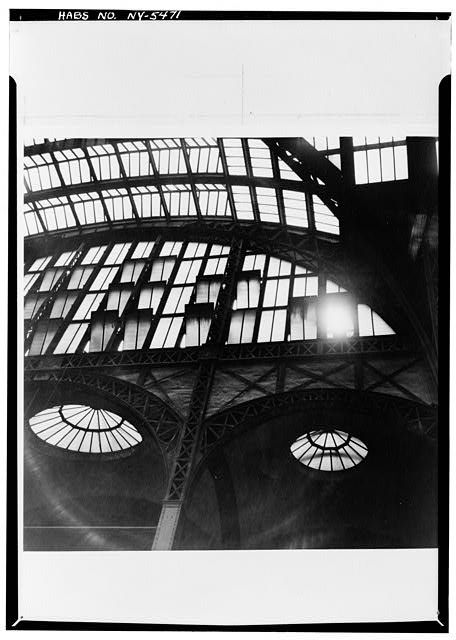Blog Archive
The Once and Future Penn Station: Part II

The bandaid that wasn’t enough. This image shows the “clamshell” designed by architect Lester Tichy in 1956. Photograph courtesy of the Library of Congress.
You may have seen the pictures of Penn Station before it went down. In fact, rushing through its windowless corridors, you may have seen the posters mounted just below the low paneled ceiling of the old, grand station. In a daze you might stand there, as your train leaves the station, wondering about what might have been: that the Penn Station of the past is in pieces in a land fill in Jersey.
David Dunlop of The New York Times points out that the fate of the station was sealed long before it was demolished in 1961. He asserts that the death knolls could be heard when Franklin Delano Roosevelt signed over? $1.5 million for new highways, or in 1946 when the Pennsylvania Railroad posted its first operating loss.

An image taken in 1962 by the Historic American Buildings Survey- and not a moment too soon. Photograph courtesy of the Library of Congress.
But the trains weren’t failing from some sudden breach of oversight. The American landscape was changing and so was travel. Dunlop cites the Federal Aid Highway Act as the first true harbinger of doom for New York’s Penn Station. Signed by FDR in 1944, the bill directed $1.5 billon to new highways…etc Even before the war was won, FDR and his advisors where envisioning the rise of the automobile. With highways came motor lodges, and the American tourist was suddenly, overwhelmingly a motorist. In 1945, intercity railroad traffic fell below 50%. In 1956, construction of interstates began to “pick up steam”. But the railroads had problems beyond cars; in 1958, a National Airlines domestic jet traveled across the country in 5 hours. And in 1958, the pink granite and miles of skylights were fading. The original Penn Station was difficult to maintain, and with shrinking funds the management applied a stopgap. Penn Station was modernized with electronic ticketing in a “clamshell” hovering within the existing Penn Station. The $2 million addendum/bandaid was designed by architect, Lester Tichy and was almost universally despised, in part because the ticketing system, which was meant to make ticket purchasing instantaneous, actually could take hours.
The other attempt at modernizing the existing station was to punctuate the interior with advertising. Dunlap quotes the famous architectural theorist and critic Lewis Mumford in saying, “One suspects that the subversion of McKim’s masterly plan was due simply to the desire to make the whole design an immense advertising display.” There were billboards and new clocks sponsored by Coca Cola, although immense timepieces had already been built into the original design. One especially punishing advert called out to train travelers to consider a Dodge. When plans to pull the station down finally became public in 1961, there was a surge of polite protest, but as some would note, it was about 20 years too late. Ada Louise Huxtable, one of the most outspoken critics of mid-century architecture in New York bemoaned, “Our own times could not only not produce such a building, but cannot even maintain it.”
The only benefit of to demolishing such a glorious building was perhaps only that it strengthened the resolve of historic preservation. Grand Central Station also was doomed to destruction, but with the help of the national mourning of NY’s Penn Station, with significant and graceful assistance from of Jacqueline Kennedy Onassis who helped draw much needed attention to the station’s plight.

Photograph courtesy of the NYPL.
Which brings us to the current plans. Cuomo is flirting with changes that will move the Amtrak ticketing hall from the current Penn Station across the street to the former Post Office building – also designed by the architecture team McKim, Mead & White. The issue is that currently Amtrak makes up only 7% of daily traffic to and from Penn Station and that the Amtrak platforms cannot also be moved, creating a longer and perhaps unnecessary schlep.
The new plans also include a ground floor renovation, but critics have noted that maintaining the upper floors of Madison Square Garden while construction crews gut its supporting levels is an engineering feat which would cost around $1 billion. At these prices, owners of the current Garden could relocate it. Not likely, though a new location would finally open the air rights associated with Penn Station, which are not currently being utilized to their best potential.
The number of commuters is projected to double in the next decade. With quarters already cramped in the current station, can we hope for a better fate?
–Posted by Julia Berick, Marketing and Communications Coordinator